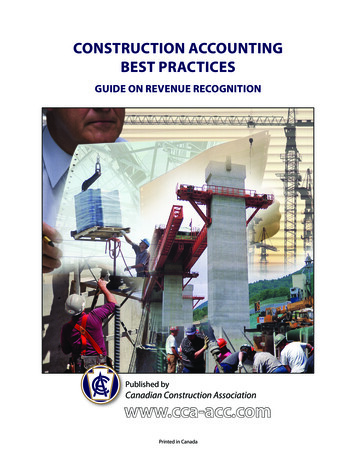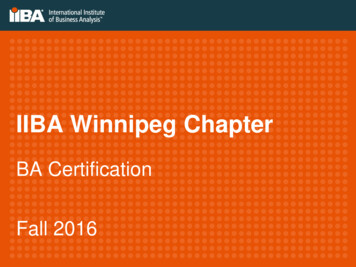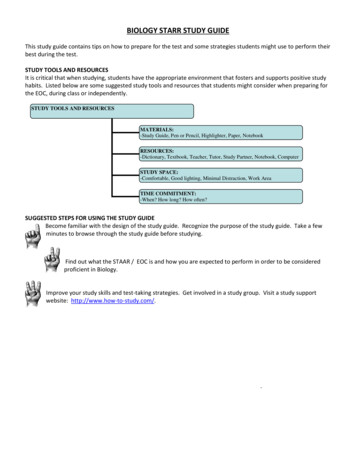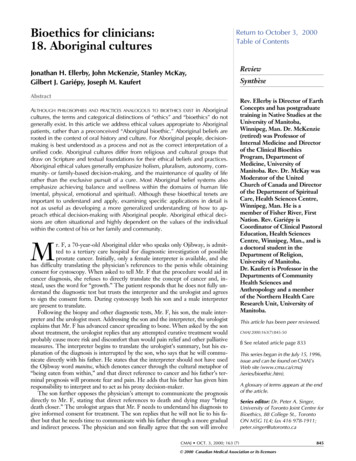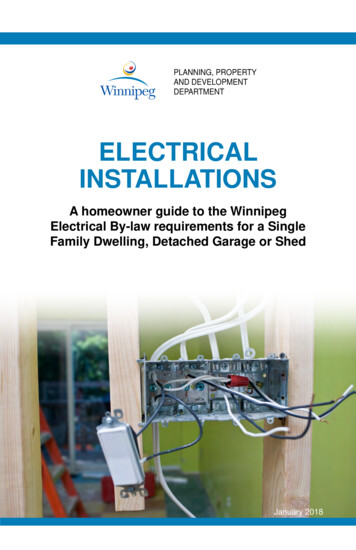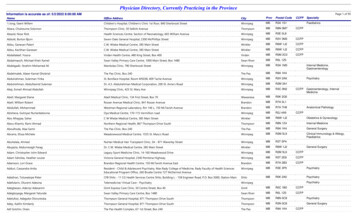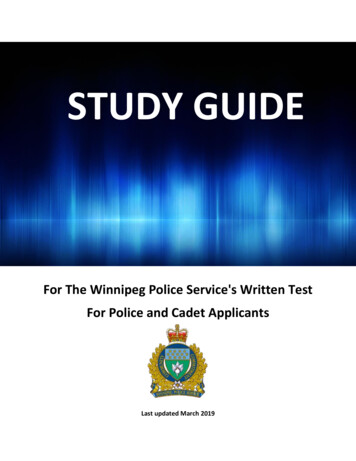
Transcription
STUDY GUIDEFor The Winnipeg Police Service's Written TestFor Police and Cadet ApplicantsLast updated March 2019
Winnipeg Police Service - Study Guide for the Written Application TestTable of Contents1. Introduction to the Written Test 3Why does the Winnipeg Police Service use a written test to screen applicants?.3How is the test structured?.3What is a passing mark for applicants?.3Why should you study for the written test?.42. Overview of the Test and Tips for Studying .5How can you prepare for the test?.5Breakdown of the five sections of the written testi.Vocabulary - word meaning. 5ii.Comprehension - understanding of what you read .6iii.Language Mechanics - writing skills such as grammar and punctuation .6iv.Language Expression - sentence structure 7v.Mathematics Concepts and Applications - problem solving .83. Practice Test .94. Answer Key for the Practice Test 292
Winnipeg Police Service - Study Guide for the Written Application Test1. Introduction to the Written TestWhy does the Winnipeg Police Service use a written test to screen applicants?The written test is intended to measure how effectively applicants communicate, apply logic, and handlethe pressure of a stressful environment. Applicants who proceed to the interview stage have anopportunity to showcase these skills in greater depth.The majority of the test questions gauge applicants' ability to comprehend and communicate in English.Clear and effective communication is crucial for police officers because: The need to be able to read, comprehend, and adhere to police procedures They must share information and coordinate with one another in high-pressure situations They interact with members of the community on a daily basis They write reports, tickets, and notes that are admissible in court They testify in court proceedings They submit intelligence reports for their colleagues in specialized units to use for investigationsand special projectsThe Service also uses the written test to evaluate applicants' logic and aptitude at basic mathematics.Problem-solving is fundamental to police work. The mathematics questions on the written test enablethe Winnipeg Police Service to assess applicants' critical thinking and problem-solving skills.How is the test structured?The written test consists of 81 multiple-choice questions based on general grade 12 knowledge.Applicants have 80 minutes to write the test.The test covers five areas:1. Vocabulary - word meaning2. Comprehension - understanding of what you read3. Language Mechanics - writing skills such as grammar and punctuation4. Language Expression - sentence structure5. Mathematics Concepts and Applications - problem solvingEach section is timed separately. Budget your time for each section accordingly - you will not have theopportunity to go back to an earlier section at the end of the test to review or change your answers.What is a passing mark for applicants?The pass mark is 65%.3
Winnipeg Police Service - Study Guide for the Written Application TestApplicants who pass the exam with a mark of 65% or better hold that mark for four years. Within thosefour years, you do not need to re-write the test if you re-apply with the Service. Cadets with a pass markon file do not need to re-write the test if they are applying to become a Police Constable within fouryears of passing the test.Why should you study for the written test? You have a set amount of time to complete each section of the test. If there is one area, such asmathematics, that you find especially challenging, you will not be able to reserve more time towork on that section.The Service looks for candidates who work hard and are dedicated. By studying for the writtentest, you are practicing the study habits you will use after you are hired and commence training.Applicants who study perform better on the written test.1Think about the time you put into applying for employment with the Service: you obtain schooltranscripts, a driver's abstract, and other documents. You fine-tune your résumé. Why not put asimilar amount of effort into the next stage of the recruitment process?Note about this edition of the study guide:This edition of the study guide was released in January 2019. This document may be revised based onapplicant feedback or if changes are made to the written test. Please visit the Winnipeg Police Service'srecruiting website for up-to-date information on how to prepare for the written application efault.aspx.1The Service conducted a pilot project in which applicants who had attempted the written test before were givenan early draft of this study guide, then re-took the test one month later. Applicants who said they studied for thetest increased their marks, especially compared to applicants who admitted they had not used the study guide.4
Winnipeg Police Service - Study Guide for the Written Application Test2. Overview of the Test and Tips for StudyingHow can you prepare for the test?It is possible to prepare for the written test. Here are some general strategies you can use to prepare forthe test: Take the time to review basic math and the rules of English grammar Set aside time to do research online or at a library to find reference materials and relevantquizzes that can help you prepare Time yourself when you take practice quizzes so you get used to completing tests with timeconstraints Think about the five areas the test covers, and consider which one(s) might be most challengingfor you, so you can spend extra time preparing for that subject Look online for resources to help you study - you can use search engines to find advice,exercises and other materials to help you prepare for each aspect of the test by inputting suchphrases as:o Vocabulary list grade 12o How to improve English grammaro Basic geometry exerciseso Best websites/apps to improve matho Examples of math word problemsI. VocabularyThe first of the five sections of the test will evaluate your knowledge on the meaning of words.Number of Questions: 18Time Allotted: 10 minutesThere are three types of questions in this section: One section provides you with a word and asks for a synonym or a word of similar meaning. One section tests your ability to put the right word into a sentence which matches the intendedmeaning provided. The third section will give you two sentences with each missing a word and ask you to find aword that fits both sentences.Tips to prepare for the Vocabulary section: Study high-school vocabulary. You can find examples of vocabulary lists online. Study homonyms and homographs. These are words which have the same spelling but differentmeanings. The third set of questions in the vocabulary section will test your ability to identify,from multiple choices, the word that can correctly be used in two different sentences.5
Winnipeg Police Service - Study Guide for the Written Application Test Commit to learning a new word every day.If you encounter an unfamiliar word in conversation or when reading, look up its meaning.Use an app or website to play games that improve your vocabulary.II. ComprehensionThis section will provide you with various pieces of information to read and then ask you a series ofquestions to identify your understanding of what you have just read.Number of Questions: 15Time Allotted: 25 minutesTips to prepare for the Comprehension section: Read a variety of passages - both non-fiction and fiction - at a high school level:o Short stories and novelso Non-fiction bookso Magazine articles on news, business, economics, science, nature, history, etc.o Official documents, policy and procedure documents After you read a piece of text for the first time, take a moment to see if you could summarizethe main message of the writing in your own words. This will help you practice reading carefullyenough to grasp the meaning of a piece of text, and using your vocabulary to paraphrase whatyou read. Look online and visit your local library for resources to improve your reading comprehension Since police officers need to be able to read and understand police procedures, practice readingsome policies and procedures to get accustomed to reading plain-language prescriptive texts.For example, you could read a few City of Winnipeg By-laws, such as:o The Winnipeg Police Service By-law (783/74)o The Graffiti Control By-law (204/2007)o The Winnipeg Police Service Regulation By-law (7610/2000)III. Language MechanicsThis section will provide you with information – whether that is a sentence, a paragraph, or a letter –and ask you choose the correct punctuation or capitalization required within sections of each.Number of Questions: 15Time Allotted: 10 minutesYou should know when to utilize various punctuation marks such as: quotation marks, exclamationmarks, semi-colons, colons, commas, or periods. Whether it is a greeting, a salutation, a proper noun, oran abbreviated word, you must be able to identify the correct punctuation for the situation.6
Winnipeg Police Service - Study Guide for the Written Application TestTips to prepare for the Language Mechanics section: Study English grammar, especially:o Punctuation Periods Commas Semi-colons Quotation marks Exclamation marks Question markso Capitalizationo Sentence structure You can find grammar review guides online or at your local library Look online for English grammar exercises that cover punctuation, capitalization, and sentencestructureIV. Language ExpressionThis section is about skills used in writing. You should have a good understanding of pronouns andcorrect verb tenses and overall sentence structure. One part of this section will provide you with twothoughts and ask you to identify the sentence that best combines these two thoughts in a manner thatstill maintains the meaning of each.Another component of this section will center on your ability to develop a topic sentence. You must beable to understand what that sentence is really focusing on and identify a follow-up sentence thatexpands on or develops that idea.Number of Questions: 18Time Allotted: 20 minutesTips to prepare for the Language Expression section: Study English grammar, especially:o Pluralizationo Verb conjugation I jump I jumped I will jump I have jumped I am jumping I will have jumped7
Winnipeg Police Service - Study Guide for the Written Application Testo Pronouns I, me, my, mine, myself You, your, yours, yourself, yourselves We, us, our, ours, ourselves They, them, their, theirs, themselves He, him, his, himself She, her, hers, herself It, its, itselfo Prepositions – on, off, through, into, etc. You can find grammar review guides online or at your local library Look online for English grammar exercises that cover pluralization, verb conjugation, pronouns,and prepositionsV. Mathematics Concepts and ApplicationsThis section tests your mathematical problem-solving skills using various math operations. You may beasked to analyze graphs, estimate, deal with square roots, deal with ratios or percentages, andformulate and solve equations.Number of Questions: 15Time Allotted: 15 minutesDuring the written test, you will not be permitted to use a calculator. You will, however, be providedwith scrap paper on which you can do manual calculations.Tips to prepare for the Mathematics Concepts and Applications section: Practice core math skills, including:o Additiono Subtractiono Multiplicationo Divisiono Square roots and exponentso Basic geometryo Percentageso Interpreting simple line graphs and bar chartso Word problemso Basic equations (solve for "n") Look online or visit your local library for study guides that cover the above math skills Use an app or website to play games that allow you to practice your math skills When doing word problems, read the questions carefully to fully understand the context for anyformulas or charts you are asked to analyze8
Winnipeg Police Service - Study Guide for the Written Application Test3. Practice TestThe following pages contain 81 questions that allow you to practice the same skills and knowledge youwill need for the written test.How not to use the practice test: Do not rely exclusively on the practice test to prepare you for the exam. Even if you answermore than 65% of the practice questions correctly, you should still review basic math andEnglish grammar before attempting the written test.Do not rely on the practice questions to be a perfect simulation of the content and difficultylevel of the actual written test.How to use the practice test: Use the practice test to get a sense of how the real test will be structured, and the types ofquestions you will be answering.Pay attention to the sections where you get questions wrong, and emphasize those areas whenyou study.When you get a question wrong, find out why. Look online for grammar rules or math lessonsthat will help you arrive at the correct answer.9
Winnipeg Police Service - Study Guide for the Written Application TestPractice QuestionsI. VocabularyChoose the word that means the same, or about the same, as the underlined word.1. Adverse conditionsa. temperateb. obligatoryc. unfavourabled. esteemed2. Insubordinate attitudea. wiseb. uglyc. enthusiasticd. disobedient3. Remunerate staffa. payb. countc. outsourced. analyse4. Redundant stepsa. aggressiveb. doggedc. elaborated. superfluousChoose the word that means the opposite of the underlined word.5. Biased attitudea. neutralb. inclinedc. discriminatoryd. flat6. Reputable establishmenta. professionalb. shadyc. unquestioningd. crumbling10
Winnipeg Police Service - Study Guide for the Written Application Test7. Anomalous occurrencea. aberrationalb. consistentc. inviolabled. unusual8. Convoluted storya. serpentineb. utilitarianc. simpled. believableRead the sentence with the missing word and the question relating to that word. Then choose theword that best answers the question.9. When the police officers interviewed each of the suspects individually, in theirnarratives emerged.Which word indicates their narratives contained sharp differences?a. impuritiesb. reinforcementsc. discrepanciesd. contraventions10. The man in custody insisted he borrowed the car from a friend, and any knowledgethat the car was stolen.Which word indicates the man denied knowing the car was stolen?a. relinquishedb. disavowedc. abdicatedd. confided11. The athlete records his physical activity and calorie intake in his training log.Which word indicates that the athlete keeps records in a consistent and dedicated manner?a. diligentlyb. intermittentlyc. intrinsicallyd. ideally12. The cat's movements suggested it was afraid of humans and possibly feral.11
Winnipeg Police Service - Study Guide for the Written Application TestWhich word indicates the cat was frantic?a. inchoateb. unassimilablec. freneticd. somnolentRead the sentences. Then choose the word that correctly completes both sentences.13.This used car is in perfect condition, but the price is still too ."Don't let the tea for more than ten minutes," Bob commented.a.b.c.d.brewsteepextremeexcessive14. She is the champion of the bowling league, and has never been defeated. It is mucheasier to paddle a canoe downriver than upriver because of the .a.b.c.d.currenttidalrecentflow15. He the rope into a coil so it wouldn't get tangled. The first aid instructor emphasizedthat you should always clean the in order to prevent infection.a.b.c.d.cutsplicedhurlwound16. The police officer issued a ticket to that motorist because she had an licence. It frustratesme that the nurses treat me like an and expect me to stay in bed all day.a.b.c.d.expiredunburdenedoutpatientinvalid12
Winnipeg Police Service - Study Guide for the Written Application Test17. When the container ship arrives at the port in Vancouver, the captain has to produce the shippingto show the authorities a list of what is being imported. During the interview with detectives,his defensive attitude began to after the detectives shot down his alibi.a.b.c.d.inventorymanifestdocumentroute18. If the children keep fighting, we should them. That store has been robbed on threeoccasions in the last year.a.b.c.d.adjoininggroupseparatecontainPractice QuestionsII. ComprehensionPractice questions 19 and 20 come from Employment and Social Development Canada's readingindicator test for employees. You can find similar practice questions on ESDC's .Read the passage below and answer the question that follows.Grout - Instructions for use1. Prepare 1.8 kilograms of grout. When the spacing between tiles is 3.2 millimeters or more, usesanded grout. When the spacing is less than 3.2 millimeters, use unsanded grout.2. Mix the grout with 500 milliliters of water in a large bucket.3. Spread the grout and scrape off any excess grout. The grout will begin to harden after about 15minutes.4. After 20 minutes, clean the surface with a sponge.5. After 40 minutes, wipe the surface with a paper towel.19. How long must floor installers wait before cleaning the surface with a sponge?a. 15 minutesb. 20 minutesc. 35 minutesd. 40 minutes13
Winnipeg Police Service - Study Guide for the Written Application TestRead the passage below and answer the question that follows.Emergency Code ManualEmergencyDescriptionCodeCode PinkA child has been abducted.Code WhiteCode PurpleHazardous materials have beenspilled.The hospital will be receiving alarge number of patients at once.A patient or other individual isbeing combative.An adult patient is missing.Code RedThere is a fire in the building.Code YellowCode GreyImmediate Action(s)Contact security to provide a description of theabducted child.Cordon off the area. Contact maintenance toclean the spill.Activate the disaster plan.Contact security. If possible, contain theindividual in an isolated area.Contact security to provide a description of themissing patient.Pull the fire alarm. Close all doors and windows.20. A patient at the hospital is angry and has thrown a dangerous chemical product onto the floor.Which code or codes should the nurse transmit over the intercom?a. Code Whiteb. Code Yellowc. Code White and Code Greyd. Code White and Code Grey and Code YellowRead the passage below and answer the question that follows.The Finance Clerk received the invoice. He recorded the date, amount, and client in his spreadsheet. Hescanned a copy of the invoice and saved it to the appropriate folder. He then emailed an electronic versionof the invoice to his supervisor to approve payment.21. Which task did the Finance Clerk do last?a. record information in his spreadsheetb. save a scanned copyc. forward the invoice to his supervisord. approve paymentRead the passage below and answer the questions that follow.The first police signal system in Winnipeg was installed in 1913. The original system consisted of158 call-boxes throughout the city along designated routes, or 'beats'. The officers were required to reportin by phone and then register each hour to both ensure their safety and receive messages. In the event anofficer was required between regular calls, the station operator could ring a bell inside the box by day orturn on a flashing red light mounted above the box or on nearby telephone poles by night.14
Winnipeg Police Service - Study Guide for the Written Application TestIn either case, the officer was only called for five minutes, and if he did not respond the patrolsergeant was notified to check on his welfare. He would ultimately have to report to the station sergeantfor missing his call. A number of ticker-tape machines in the station recorded the calls by the positionnumber in the box used by the officer, which was automatically followed by the box number. Each boxhad a different three-digit number, and the first digit even told the district.22. How did a station operator contact a police officer on patrol during the day?a. Ringing a bell in a call boxb. Sending the patrol sergeantc. A flashing red light on or near a call boxd. Using a ticker-tape machine23. If the intersection of Jarvis and Andrews was located in District 5, which of the following could be thenumerical code for the call-box at that location?a. 5022b. 2675c. 205d. 52224. What would happen if a patrol officer did not respond to a call within five minutes?a. He would be admonished by the station sergeantb. He had to report to the station sergeant later in his shiftc. The patrol sergeant reported a state of emergencyd. A red light on the call box started flashingThis passage is an adaptation of an article by Gloria Dickie, published by Canadian Geographic inDecember 2017 a-conservation-inspiration; this link is provided to acknowledge the originalpublished material, but sample test questions are based strictly on the summary of the article below).Read the passage and answer the questions below based on the information provided in the passage.In the mid-1990s, 100 elk-vehicle collisions occurred annually in Banff National Park. Today,that number is almost zero. This statistic, along with other data collected by the Western TransportationInstitute, indicates the Parks Canada wildlife corridors are working.Over the last three decades, the Canadian government allocated over 400 million to upgrade andadd more lanes to the 180km of Trans-Canada Highway running through Banff National Park. Thousandsof vehicles were using the highway each day, which cuts directly through the park and the home rangesand corridors of local wildlife. Collisions between vehicles and wildlife were a growing concern. As aresult, a quarter of the highway-improvement budget was reserved for installing fencing along thehighway and building overpasses and underpasses for wildlife to use.15
Winnipeg Police Service - Study Guide for the Written Application TestThe overpasses are concrete structures topped with wildflowers and trees; they provide safepassage over the Trans-Canada for local wildlife including grizzly bears, elk, deer, and other animals. Theculvert-like underpasses are preferred by black bears and mountain lions. In all, the WesternTransportation Institute has recorded large mammals using the structures over 200,000 times in the 17years it has been tracking use of the passages.The over- and underpasses were a relatively novel idea when they were constructed along thesection of the Trans-Canada Highway that passes through Banff National Park. A few small wildlifecrossings existed in the eastern United States, but there was no precedent, or even much publicconfidence, that the undertaking in Banff would work. Now, delegations from around the world arevisiting Banff to study the corridors. They are considering whether these successes can be adapted to theroadways and animal populations of Montana, Washington, Mongolia, Argentina, and China.25. Based on its tone and content, which of the following best describes the passage?a.b.c.d.parablecase studycautionary talesuccess story26. Which of the following is the best example that the corridors were effective at meeting theirobjectives?a.b.c.d.there have been fewer elk-vehicle collisionsthe corridors have attracted notice from other countrieslocal wildlife populations have become more stabletraffic flow in Banff National Park improved27. According to the article, why was the construction of the overpasses and underpasses sonoteworthy?a.b.c.d.Banff is Canada's most-visited national parkThere were only a few examples of the corridors in existence at that timeGrizzly bears are a species of special concern in BanffThey cross approximately 180km of highway28. Which of these statements best summarizes the passage?a. The wildlife corridors over and under the Trans-Canada Highway were not a waste of money.b. The wildlife corridors over and under the Trans-Canada Highway have received internationalattention because of their effectiveness.c. The wildlife corridors over and under the Trans-Canada Highway are proof of Parks Canada'sconservation efforts.d. The wildlife corridors over and under the Trans-Canada Highway are used by bears, elk, deer,mountain lions, and other animals.16
Winnipeg Police Service - Study Guide for the Written Application Test29. According to the passage, which of the following statements best reflects public attitudes toward thewildlife corridors before they were constructed?a.b.c.d."This is a valuable project.""We should follow the lead of the United States.""We are not sure these corridors will work.""This is an opportunity for Canada to be a leader in conservation."The following is a set of rules and guidelines for an online contest from the Red River StationeryCompany, a fictional company. Read the passage and use it to do the questions below.1. Eligibility: No purchase necessary. Maximum of one entry per person. This contest is openonly to those who sign up online and who are 18 years of age or older as of the date of entry. The contestis only open to legal residents of Canada, and is void where prohibited by law. Employees of the RedRiver Stationery Company, its affiliates, advertising and promotion agencies, and suppliers, (collectivelythe “Employees”), and immediate family members and/or those living in the same household ofEmployees are not eligible to participate in the contest. The contest is subject to all applicable federal,provincial, and local laws and regulations.2. Contest Period: Entries will be accepted online starting on September 1 and ending December15 at 11:59 p.m. (CST).3. How to Enter: The contest must be entered by submitting an entry using the online formprovided at redriverstationery.com. The entry must fulfill all contest requirements, as specified, to beeligible to win a prize. Entries that are incomplete or do not adhere to the rules or specifications may bedisqualified at the sole discretion of the Red River Stationery Company. You may not enter more timesthan indicated by using multiple email addresses, identities, or devices in an attempt to circumvent therules. If You use fraudulent methods or otherwise attempt to circumvent the rules, your submission maybe removed from eligibility at the sole discretion of the Red River Stationery Company.4. Winner Selection and Notification: Winner will be selected by a random drawing under thesupervision of the Red River Stationery Company. Winner will be notified by email within five (5) daysfollowing selection of Winner. The Red River Stationery Company shall have no liability for the winner’sfailure to receive notices due to spam, junk e-mail or other security settings or for the winner’s provisionof incorrect or otherwise non-functioning contact information. If the winner cannot be contacted, isineligible, fails to claim the prize within 14 days from the time award notification was sent, or fails totimely return a completed and executed declaration and release as required, the prize may be forfeited andan alternate winner selected. Receipt by the winner of the prize offered in this contest is conditioned uponcompliance with any and all federal, provincial, and local laws and regulations. Any violation of theseofficial rules by the winner (at Red River Stationery Company's sole discretion) will result in the winner'sdisqualification from the contest and all privileges as the winner will be immediately terminated.30. Which of the following prospective contest entrants is not eligible to win?a.b.c.d.A new customer of the Red River Stationery CompanyAn existing customer of the Red River Stationery CompanyA person who does not shop at the Red River Stationery CompanyAn employee of the Red River Stationery Company17
Winnipeg Police Service - Study Guide for the Written Application Test31. Which of the following is not a responsibility of the Red River Stationery Company?a.b.c.d.to accept entries until December 15to choose a winner at randomto contact the winner by December 20to call the winner if the winner does not claim the prize within 14 days32. Contest entrants are ineligible to win if:a.b.c.d.they enter onlinethey do not make a purchase at Red River Stationery Company within the contest periodthey enter more than oncethey have won a prize from the Red River Stationery Company within the last year33. The contest winner forfeits their entitlement to a prize under all of the circumstances outlinedbelow, except for:a.b.c.d.the winner turns 18 on December 14the winner provides incorrect contact informationthe winner's email account blocks or filters the email notifying the winnerthe winner violates the contest rulesPractice QuestionsIII. Language MechanicsThis section is about skills used in writing. For the following questions, decide which punctuation mark,if any, is needed in the sentences.34. "The grass is getting pretty long" Marla commented to her brother.a. ,b. !c. ;d. none35. The backpack that is full of books belongs to my friend.a. .b. ,c. ;d. none18
Note about this edition of the study guide: This edition of the study guide was released in January 2019. This document may be revised based on applicant feedback or if changes are made to the written test. Please visit the Winnipeg Police Service's recruiting website for up-to-date information on how to prepare for the written application test:


